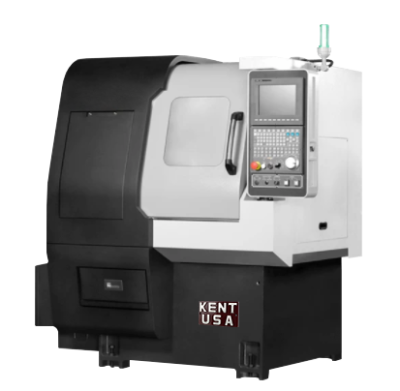
Kent CNC GSL Series CNC Lathes feature a gang type structure with an inclined bed structure design. These features effectively save tool changing time. The GSL Series Lathes are equipped with a hydraulic six-station turret and have power-driven tools including edge milling, tapping, drilling, and are also capable of grooving processing. These CNC Lathes have extraordinary precision and help shop productivity.
The Gang Type Tooling System aids with high-speed cutting and holds high accuracy during turning of any part. These CNC Lathes are equipped with linear guides for the X and Y axes to provide stable and accurate cutting. As a standard feature, these machines are equipped with a High Precision C-Axis Indexing function.
Standard Accessories
- Turning Tool Holders × 3
- Drill Holder (Single Hole) Ø .78 x 2
- Drill Holder (Double Holes) Ø .78 x 1
- Stop Bar × 1
- Drilling Shaft × 3
Optional Accessories
- Spindle Collets (EGURO 1020; FUJI 1125; FUJI1132; INDEX 42#)
- Side Power Driven Tool (Servo Motor)
- Vertical Power Driven Tool (Servo Motor)
- Front Power Driven Tool (Servo Motor)
- Auto Bar Feeder Machine
- Parts Conveyor
- Chip Conveyor With Cart
- Oil Mist Collector
- Auto Volt. Stabilizer
- Auto Volt. Transformer & Stabilizer
Contact Details
Related Glossary Terms
- computer numerical control ( CNC)
computer numerical control ( CNC)
Microprocessor-based controller dedicated to a machine tool that permits the creation or modification of parts. Programmed numerical control activates the machine’s servos and spindle drives and controls the various machining operations. See DNC, direct numerical control; NC, numerical control.
- gang cutting ( milling)
gang cutting ( milling)
Machining with several cutters mounted on a single arbor, generally for simultaneous cutting.
- grooving
grooving
Machining grooves and shallow channels. Example: grooving ball-bearing raceways. Typically performed by tools that are capable of light cuts at high feed rates. Imparts high-quality finish.
- milling
milling
Machining operation in which metal or other material is removed by applying power to a rotating cutter. In vertical milling, the cutting tool is mounted vertically on the spindle. In horizontal milling, the cutting tool is mounted horizontally, either directly on the spindle or on an arbor. Horizontal milling is further broken down into conventional milling, where the cutter rotates opposite the direction of feed, or “up” into the workpiece; and climb milling, where the cutter rotates in the direction of feed, or “down” into the workpiece. Milling operations include plane or surface milling, endmilling, facemilling, angle milling, form milling and profiling.
- tapping
tapping
Machining operation in which a tap, with teeth on its periphery, cuts internal threads in a predrilled hole having a smaller diameter than the tap diameter. Threads are formed by a combined rotary and axial-relative motion between tap and workpiece. See tap.
- turning
turning
Workpiece is held in a chuck, mounted on a face plate or secured between centers and rotated while a cutting tool, normally a single-point tool, is fed into it along its periphery or across its end or face. Takes the form of straight turning (cutting along the periphery of the workpiece); taper turning (creating a taper); step turning (turning different-size diameters on the same work); chamfering (beveling an edge or shoulder); facing (cutting on an end); turning threads (usually external but can be internal); roughing (high-volume metal removal); and finishing (final light cuts). Performed on lathes, turning centers, chucking machines, automatic screw machines and similar machines.

